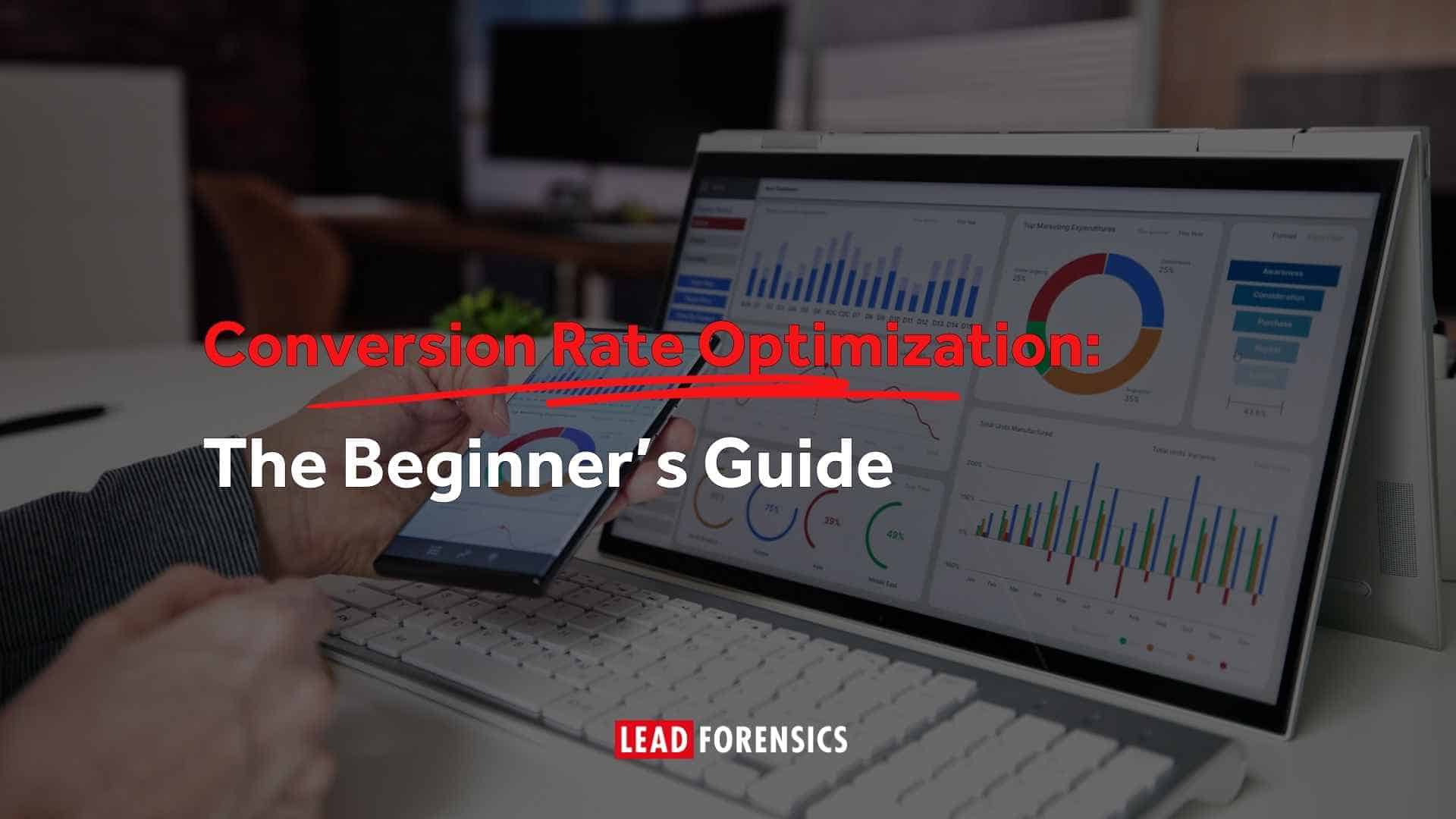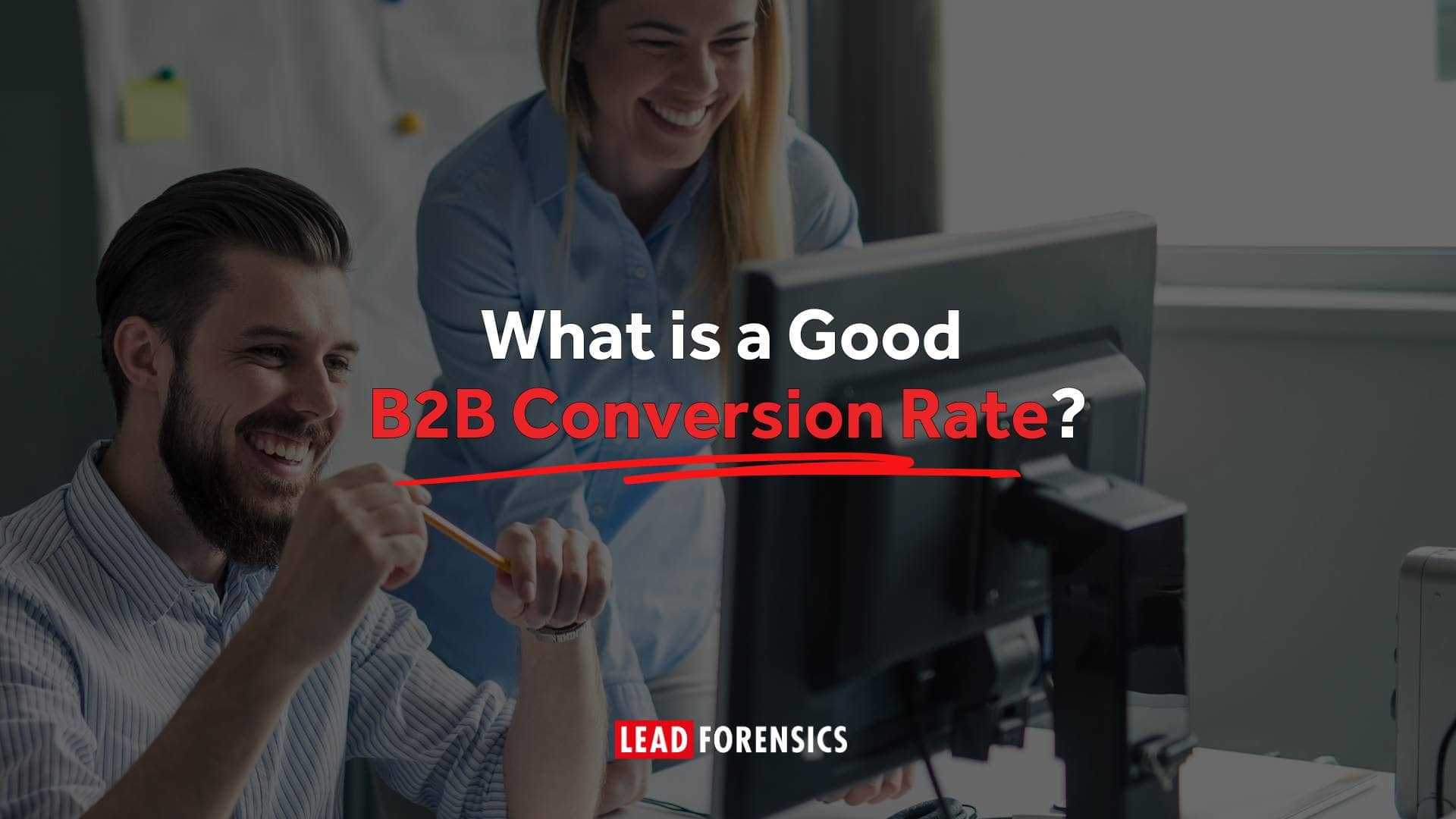This B2B conversion rate optimization guide for beginners will walk you through the entire conversion rate optimization process so you have a better understanding of how it actually works, and how you can use this to improve lead generation and conversions on your B2B website.
Jump to:
- What is CRO?
- What is a Good Conversion Rate?
- CRO Metrics
- How to Get Started With CRO
- What’s Next?
- Helpful Tools for CRO
What is CRO?
CRO – short for conversion rate optimization – is all about increasing the number of website visitors that complete a desired action. In the B2B world, conversion rate optimization means growing the number of people who do specific things like filling out a form, downloading a PDF, or making an online purchase.
CRO usually involves:
- coming up with a heap of ideas to improve your website
- checking the best ideas work by testing them
- deploying changes that work and choosing the next idea to pick up.
Why is CRO important for B2B Sales?
You probably work really hard driving people to your website, but it can feel like you’re wasting money when the majority of those people don’t convert. Conversion rate optimization helps to reduce this waste. By achieving more from your same marketing efforts, you’re able to nudge your return on investment (ROI) higher without spending more money.
And by making the road to conversion smoother, you can reduce gap between when a prospect thinks about a solution and the moment they’re ready to buy. This shortens the sales cycle, which means you can close more deals, speed up payments and improve your cash flow.
How Does Conversion Rate Optimization Work?
Conversion rate optimization works by holistically reviewing a website (or specific webpages) to uncover the reasons why people might not be converting, and then trying to find ways to address these challenges to remove friction from the user journey.
There are many ways that CRO works, but some examples include:
- Improving the language of CTAs across the whole website
- Streamlining web forms to encourage more completions
- Rewriting web copy to communicate benefits or reassure B2B buyers more effectively
- Restructuring your key landing pages to deliver the most relevant content first
Conversion Rates Explained
The average conversion rate for B2B websites is just 2%. But this varies by industry.
For example, it’s B2B SaaS that gets the lowest conversion rates, according to research by First Page Sage.
So, what is a good conversion rate for B2B websites? If you’re a B2B engineering business, you’ll want to beat the average of 1.2%. However, if you’re a legal services company, you could be disappointed with a 6% conversion rate because the average is actually 7.4%.
But benchmarking conversion rates isn’t that simple; we often separate these conversions into macro and micro conversions, and each will have a different rate.
Macro vs Micro Conversions
Macro conversions are the big things, such as booking a demo or completing sale or inquiry form, while micro conversions are the smaller steps a prospect takes along their journey. For a B2B company, these micro conversions could be anything from subscribing to your newsletter or registering for a webinar to viewing a specific page.
The CRO metrics you need to know
When it comes to B2B marketing, there are multiple marketing metrics to consider:
- Conversion rate measures the percentage of sessions that completed a specific conversion action
- User conversion rate measures the percentage of users that completed a specified conversion action
- Click-through rate measures the percentage of users who click on a specific link or call-to-action
- Bounce rate measures the percentage of users that leave your site after viewing just one page
- Exit rate measures the percentage of pageviews that were last in a session.
- Average session duration measures the average amount of time that users spend on your website
- Customer acquisition cost measures the total cost of acquiring a new customer
However, every business is different and there may be more relevant metrics to focus on. For example, maybe you want users to scroll to a specific point on a landing page or you want people to watch the duration of a video embedded in a page.
Knowing what you should measure is an essential step of any CRO project. This data lets you benchmark your current performance and see how any conversion rate optimization efforts help you get more leads and customers.
How to get started with CRO
Before you jump in and start making site-wide changes to boost conversions, you need to do your research and get a sense of what’s actually happening on your domain.
Audit Your Website
First, start by assessing the appearance of your site. Act like a prospective customer and pay attention to any points of friction in the journey through the site. Ask your colleagues from other departments to do the same and watch what they do, in case they highlight any pain points you may be unaware of.
Run a Speed Test
Check your website load speed. How quickly does the homepage appear on desktop and mobile? Are your key pages loading quickly enough?
Dive Into Data
What do your conversion-focused metrics tell you about user behavior? Which pages are over- and under-performing in terms of conversions? Which pages are the most valuable? Where are the opportunities?
Prioritize Your Pages
Once you’ve got the right data, you need to find out which pages have high traffic but low conversions. These are the pages that offer the highest opportunity to see a return on your investment.
You can further prioritize this list by looking at the most essential pages first. Anything like product pages, landing pages and checkout pages are directly impact your revenue and so they should be prioritised for CRO.
Review The User Journey
When you know which page(s) to focus on, it’s time to analyze your typical visitor journey. Find out which sources send them to the page/website, how long they stay on each page and what they explore.
It helps if you can document the user journey and list at which stage they visit each page. This allows to you to ensure you optimize all the key pages in the journey and also report accurately on the impact of your conversion rate optimization work.
Think Like Your Buyers
Take yourself through the user journey again, but this time imagine you’re a prospect. Write a list of anything that might be putting people off from converting.
Come up with ideas for improvement
Refer back to your list of potential blockers and try to think of ways you could solve this. When it comes to CRO, the kind of things people often test are:
- Could a change to the copy encourage people to convert?
- Does the wording of the button need to be updated?
- Would a pop-up get more people to inquire?
- Does a chatbot make it easier for people to leave their details?
- Should the order of information on the page change?
- Would personalized content encourage more conversions?
- Do you need to put more calls to action throughout the page?
- Should that really long blog be a gated piece of content?
Prioritize Your Ideas
You might have 10+ ideas for your conversion rate optimization project but no clue where to start. In this scenario, you could use the ICE framework to help you choose which ones to review first:
- Impact. Which ideas would have the biggest impact on conversions?
- Confidence. How confident are you that this will work?
- Ease. How easy and cost-effective is this to try?
A high impact, high confidence and high ease example could be rewriting the copy on your landing page or restructuring the layout of content.
A high impact, high confidence and low ease idea could be personalizing your website for visitors from specific industries. We know it works, but it requires more investment.
Conversion Rate Optimization Testing
When you’ve got your prioritized idea and your prioritized pages, it’s time to think about how to actually start your conversion rate optimization testing.
Because making changes to your B2B website are high risk, it’s important you test anything new before you deploy it across the entire website.
But this CRO testing is the secret to success: according to Entrepreneur, testing can increase a business’s conversion-rate by as much as 400%.
Try A/B Testing First
If you’re a beginner to CRO, you might be asking: what is A/B testing?
A/B testing allows you to serve half your visitors a new version of the webpage and the other half see the existing, control version. This reduces the risk of showing everybody a version of a page that is less persuasive and actually makes conversions tank.
It also gives you data on how each version performs, so you can see the impact of any changes. For conversion rate optimization tests, A/B splitting allows you to see which version gets more conversions and how much the increase or decrease is.
A/B tests are easy to set up and manage, which is why they’re recommended for CRO beginners. In fact, 77% of businesses run A/B test on their website, according to Invesp.
Consider Multivariate Testing
If you want to test more than one option, you’ll need to use multivariate testing. Instead of splitting your visitors across two different versions, multivariate testing allows you to use a higher number of versions and compare their performance.
This type of CRO test is particularly powerful if you have two competing ideas. For example, you might feel strongly that one change will improve conversions but the CEO thinks something else will drive the biggest change. With multivariate testing you can pit the ideas against each other and get empirical evidence of which one is best.
Run a Fair Test
If you test too many things at once, you won’t know what had the biggest impact. That’s why your conversion rate optimization testing should be incremental: you should test one change at a time. This helps you learn what your audience responds well to – and what they don’t.
Deploy the Winning Element To All Traffic
When you know what works, it’s time to make that change to the page permanently and make sure 100% of your visitors can benefit from the improvement. Don’t take too long to implement what works or you’ll be missing conversions unnecessarily. Bing made a single ad display change that increased revenue by 12% after A/B testing it, according to Harvard Business Review.
What’s Next? More CRO
We always want more conversions, which means conversion rate optimization never ends. It’s a continuous process and there is not shortage of things waiting to be tested.
After all, your audience and their preferences may change, and it’s up to you to ensure your website keeps up with these changes.
Conduct tests regularly, aiming to continually improve your website conversion rate and maximize the number of leads you generate through your business website.
To capitalize on every on-site opportunity, including those that don’t make an inquiry on the first visit, consider adding website visitor tracking software to your site to automatically transform them into an actionable lead. So, you’re probably wondering which tools are out there to help you with your testing! Read on to check out our recommendations for conversion rate optimization tools.
Tools To Help With CRO
You don’t have to do your conversion rate optimization manually; there’s a whole range of tools for conversion rate optimization that will make different stages of the process easier.
Some of the best tools that can help you with CRO include:
- GA4 (Google Analytics). This free website analytics tool will help you learn more about how people use your website and identify your CRO opportunities.
- Crazy Egg. View heat maps to analyze user behaviour, replay visitor sessions to watch their engagement, review mouse movement to see how they use your site, track clicks, and beyond.
- Hotjar. More ways to see how users behave on your site, including heat maps, session replays, click tracking and mouse movement monitoring, plus you can survey users and more.
- VWO. This enterprise solution highlights user experience bottlenecks so that you can frame your user experience problems and work on them, amongst many other features.
- Google Optimize. Run tests on your website, including A/B and multivariate tests, and give personalization a try.
- Webeo. This personalization tool lets you serve custom content to audiences from specific industries.
- Optimizely. This experimentation platform is made for websites with high traffic who want to run tests, try personalization and check AI-based recommendations.
- Lead Forensics. This solution uncovers which companies are visiting your website but not engaging to give you the insights you need to optimize user journeys and increase conversions. Want to learn more? Book your Lead Forensics demonstration today!








